
STEM
Science, Technology, Engineering, Mathematics
Tamagawa University Quantum ICT Research InstituteUltimate cryptography to safeguard infrastructures from cyber attack
- Development begins on the Quantum Enigma -
In the 1980s, Tamagawa University became among the world’s first in launching research on the fundamental theories of quantum information and quantum communication. In April 2011, Tamagawa University eatablished the Quantum ICT Research Institute. The Institute comprises the Quantum Information Science Research Center, which pursues basic research on quantum information science, and the Quantum Communication Research Center involved in research and development to achieve socially beneficial technologies based on new theories derived by research on quantum information theory. Tamagawa University also organized the International Conference on Quantum Communication, Measurement and Computing, the world’s largest conference and said to have been the initial driving force behind the development of researchers in the field of quantum information science. In recognition of this achievement, Tamagawa University is referred to as the founder of the field of quantum information science.
The Quantum ICT Research Institute has developed so called Quantum Enigma powered by Yuen-2000 protocol which is a new quantum cryptography that relies on macroscopic quantum effects. When this cryptography finds practical applications in the near future, it is expected to become the most powerful defense against cyber attack. Last year, researchers of the Institute experimentally demonstrated encrypted data communication at ultra-high speeds of 40 gigabits per second. The Institute is currently engaged in joint development efforts with companies and other organizations inside and outside Japan.
Referring to this ultimate encryption technology as the “Quantum Enigma,” an honorable designation granted to the King of Cryptography, the Institute will begin research and development on standardization efforts starting this year.
These R&D activities are spearheaded by Associate Professors Fumio Futami and Kentaro Kato, who are expected to serve as team leaders in this new era.
Cyber attacks on the infrastructure
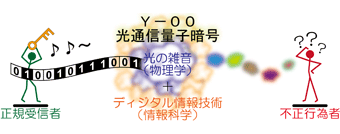
A high-speed optical communications as infrastructure is essential to the control of the power supply, finance, transportation systems, etc. that undergird our modern society. The communications infrastructure is generally implemented using next-generation data centers linked over the Internet (cloud computing systems).
The rise of cyber attacks on these communication infrastructures in recent years has generated serious concerns. Currently in Japan, cyber attacks are not adequately identified and countermeasures tend to be inadequate. Since the current cyber attacks are based on software that attacks servers, it is possible to block cyber attacks on data centers through firewall technology.
The most serious threats are attacks on communication lines, and in general telecommunications carriers would rather hide this fact in public. Although such attacks are infrequent, attacks of this type can cause devastating damage to telecommunications carriers and to users, since the attacks allow copying of all data stored by data centers. Cryptographic technology of ultimate strength is required to protect against such attacks. The first signals of the need for such cryptography emerged in 1998, when the Defense Advanced Research Projects Agency (DARPA) under the United States Department of Defense established an initiative for a next-generation Internet currently so called cloud computing with data centers, along with plans to develop new and fundamental technologies for protecting the high-speed communication lines linking the data centers. After many years of basic research, Tamagawa University and Northwestern University completed development work the necessary foundational technologies. Last year, DARPA disclosed detailed specifications intended to promote the development of a practical engine. The Quantum Cryptography system powered by Y-00 protocol developed by Tamagawa University is the only current system capable of meeting DARPA’s requirements. Expectations for practical applications are quite high.
From this year, the Quantum ICT Research Institute will systematically reorganize conventional technologies to achieve commercial cryptography applications. At the same time, the Institute will launch efforts to develop the Quantum Enigma as an ideal form of quantum cryptography based on Y-00 protocol.
What is the Quantum Enigma?
The Enigma (“enigma” for “mystery”) was the name of the most sophisticated encryption device developed by the German army during the war, based on the state-of-the-art cryptographic knowledge of the time. In those years, encryption meant the rearrangement of the letters in the original message into repeating irregular patterns. If the sequence period was short, the encrypted message could be deciphered through an exhaustive search for the encryption pattern. This made creating long period of sequences the key to ensuring high security. The Enigma encryption used by the German army during the war boasted the longest period at that time.
It’s now easy to design a long period of pseudorandom number sequence. Nonetheless, the technology associated with the Enigma encryption and code breaking represents a cornerstone of cryptography and a new chapter in the history of cryptographic techniques, one of universal interest to cryptography researchers.
Quantum Cryptography powered by Y-00 protocol consists of a communication device designed by mathematical encryption algorithm and multi-level optical modulator to encrypt the optical signals. The encrypted optical signals are also concealed by quantum noise when eavesdropper tries to receive such encrypted optical signals. Once the encrypted optical signals are completely hidden by quantum noise, even the original encrypted signals cannot be reproduced. The authorized receiver can decipher the encrypted optical signals without the disturbance of quantum noise?making it a mysterious form of cryptography indeed. Thus our new technology is profitable to call as “Quantum Enigma”.
Many technical issues remain to be resolved to develop a technology that can completely conceal encrypted optical signals. Through concerted joint efforts, the researchers at the Quantum ICT Research Institute are tackling various challenges to achieve an ideal quantum enigma.
“STEM” education for bolstering the new vegetable production system, “Farmtory”
As food demand is predicted to rise worldwide, Japan faces a pressing need to rebuild its agricultural industries. The combined total population of China, India, and the African nations currently accounts for almost half of the world’s population. The countries in these three regions are expected to undergo rapid economic development, sharply increasing food demand. These prospects have raised great concerns. As the economy of a country develops, the people of that country inevitably seek out a richer and more varied diet. Backed by the economic strengths of their countries, residents of advanced nations have enjoyed access to a wide and abundant range of food.
Japan’s agricultural industry currently faces serious challenges. With a population of 130 million, Japan has a food self-sufficiency rate of 40% on a calorie basis or 27% on a grain production basis. With a system of agricultural production dominated by family farms and elderly workers, Japan cannot expect rapid improvements in the food self-sufficiency rate or efficient agricultural production. Instability in global politics affecting imports of food into Japan may have catastrophic effects on the nation. In light of the potential risks inherent in the global food system, Japan must strengthen its food production capacity and boost the self-sufficiency of its food supply.
Systematized farming techniques are currently drawing attention as a way to improve food productivity. Among the associated techniques is greenhouse hydroponics, developed in the Netherlands and elsewhere as an extension of protected horticulture. In Japan, many universities and corporations have attempted to develop an indoor-type crop production system based on artificial light, such as fluorescent lamps, but no practical systems have emerged to date, in large part due to the modest gains in production efficiency achieved compared to the high cost of the systems and electricity used. For many years, Tamagawa University has sought to develop a new food production system based on LED light sources. LED technology is capable of emitting sharply focused monochromatic light with narrow band width, such as red light or blue light. We are seeking to harness the unique characteristics of LED light to achieve precise control of crop growth and quality.
Producing crops in a completely controlled cultivation environment requires and draws on research efforts in various areas of technology. To develop a plant cultivation technique based on LED light, we had to develop LEDs with significantly higher output and durability than conventional ones. This required manufacturing technologies capable of producing compound semiconductor chips and device technologies for effectively extracting light emitted from LED chips. An application of basic photobotanical physiology is essential to controlling plant growth, plant physiology, and ultimately crop quality by utilizing pure monochromatic LED light. In addition, developing a new LED vegetable production system requires the integrated application of various scientific and engineering technologies, including optical sensing technologies to detect and control growth conditions, simulation technologies to optimize cultivation environments, and ICT technologies to link cultivation management and market information.
The days have long passed when a new technology or new consumer product could be developed based on the knowledge and expertise of one field of science. Now, new technologies emerge from the integration of scientific and technological achievements drawn from a wide range of fields, including basic science, engineering, and applied technologies. Developing new technologies from technologies spanning many fields requires the development and support of researchers to ensure they acquire a solid understanding of basic scientific principles and are capable of applying a cross disciplinary approach to their knowledge. This points to the importance of a consistent and coherent approach to education, ranging from science and mathematics at the primary/secondary levels to basic and specialized topics in higher education and technical training at research institutions. Based on this recognition, Tamagawa Academy K-12 & University has an extensive and strategically designed range of course offerings.
STEM (Science, Technology, Engineering, and Mathematics) is gaining growing prominence in the field of education, due to widespread recognition that an education encompassing science, technology, engineering, and mathematics, as well as the development of human resources in these fields, are critical to the development of scientific technologies with the potential to create new value. Indeed, the development of the new vegetable production system using LED required the integrated cross disciplinary application of research results and data drawn from a wide range of sciences, technology, and engineering. We believe developing human resources with extensive knowledge is essential to achieving significant research results and to developing new technologies.
“Farmtory,” a word combining “farm” and “factory,” is the name coined by Tamagawa University for its newly-developed LED vegetable production system. The name suggests a technology that integrates cultivation techniques fostered at farms with production techniques devised at factories. We want to use this term to refer to comprehensive food production systems developed through various technologies and efforts, including engineering technologies related to LED, high-quality vegetable cultivation technologies based on LED technology, vegetable production control technologies, and education/training systems for developing the specialized technicians required to maintain the technologies involved in production.
Farmtory represents a new applied technology for food production, one we are proud to count among the results achieved by the educational philosophy of Tamagawa Academy K-12 & University, a philosophy that emphasizes the science, mathematics, and technology represented by the STEM concept. By nurturing STEM as the growing stem of Tamagawa Academy K-12 & University, we hope to see a flowering of leaves and blossoms such as Farmtory.
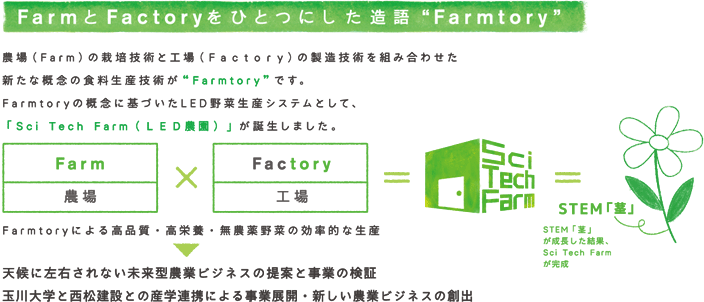

STEM education and robot development activities at Tamagawa
Japan is well known to be a science and high technology oriented country. The key factor supporting this national development is STEM (Science, Technology, Engineering, and Mathematics): the basic ability grounding scientific understanding of phenomena. The technology-oriented society is composed of citizens’ individual technical ability, of which leads to the creation of splendid products pronounced all over the world. By this, Japan is able to export advanced products and in return, import food, fuels and all other necessities to fulfill the citizens’ basic needs. This fundamental commodity flow which relies on individual ability is what makes STEM the driver of our nation. In this sense, there is no doubt that STEM occupies a place of undeniable importance in the field of education, and Tamagawa Academy pursues various activities to foster human resources characterized by the high levels of STEM.
Tamagawa University has established three research centers: the Research Institute, the Brain Science Institute, and the Quantum ICT Research Institute. Additionally, three other projects are also under operation of which are TSCP (Tamagawa Sustainable Chemistry-powered-vehicle Project), TWP (Tamagawa Windmill Project) and TRCP (Tamagawa Robot Challenge Project). These facilities and projects promote the discovery of new knowledge as well as the development of new technologies through advanced research and activities within their respective fields. The students participation in these research projects and activities are hoped to contribute to achieving a high level of Tamagawa University STEM education.
TRCP (Tamagawa Robot Challenge Project)*1
Robot is a state-of-art field of engineering in the sense that our lives are going to be supported by useful tools, and is by no means highly influential. However, robots are also fascinating machines that draw keen interest from children and young adults. Robot competitions are common these days, such including the RoboCup*2 and World Robot Olympiad (WRO), whose goals are to promote the educational merit through robotics. Tens and thousands of children, university students, and adults from all around the world participate in these competitions. STEM education goes beyond learning the technologies required to develop robots. STEM enhances skills across a broad spectrum representing STEM’s foundations, including teamwork and strategic problem-solving capabilities. Although the benefits of STEM educational activities are clear, the current K-12 and university/graduate school curricula have not been adequately systematized. This is a critical issue for achieving effective STEM education.
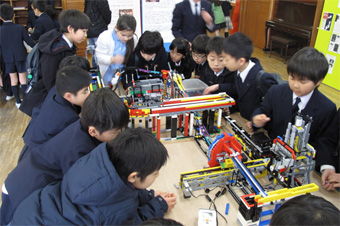
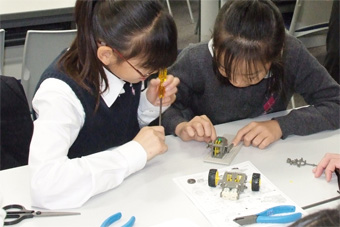
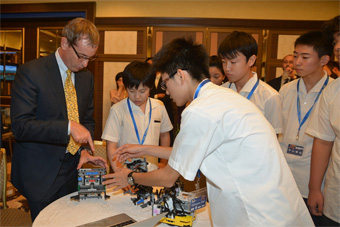
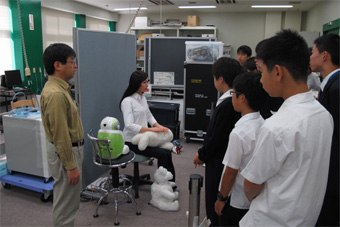
The Tamagawa Robot Challenge Project (TRCP) seeks to achieve consistent STEM education across all levels of learning at Tamagawa Academy ranging from K16 to graduate school and research institutes. To this end, the TRCP serves to systematically link and coordinate robot-related activities at all academic levels at Tamagawa Academy K-12 & University. At Tamagawa Academy, grade 4 students are given the opportunity to produce robots. From grades 5 to 12, the students design and create robots for competitions through extracurricular activities as members of a science or robot club. Through these efforts, the students polish their STEM skills and learn how their efforts are evaluated by third parties. In grades 10 to 12, students learn robot programming as a part of their information science class. Students involved in Project-Based Learning (PBL) at the College of Engineering at Tamagawa University seek to produce working robots on their own. Ultimately, undergraduates, graduate students, and research scholars participate in the RoboCup senior division to showcase on a global stage STEM skills refined through daily effort.
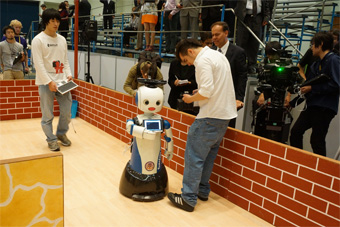
Students at Tamagawa Academy K-12 & University have achieved high marks in robot competitions held in Japan. Our students carry on their predecessors’ activities to realize continuous and systematic robot development. In the RoboCup world competition, Tamagawa University students have won the world championship and second place honors, each on two occasions. The students responsible for these achievements were highly regarded, and graduate our university with great honor. In recent years, the activities of their school instructors have drawn notice and recognition in the form of various awards and prizes.
Our mission at Tamagawa Academy K-12 & University goes beyond boosting first-rate robotics instruction and research. To enhance the STEM skills of young people and motivate our students? the future leaders of Japan? we are systematically organizing our accumulated know-how and incorporating it into our curricula. How will the teachers and instructors, involved in TRCP at Tamagawa Academy K-12 & University, strive to design effective teaching materials and to identify the most effective sequence of lessons? What kind of activities are most motivating for the students? How do we make the joy of STEM as vivid as possible for the most effective acquisition of STEM skills? These are the challenges that the teachers involved in the TRCP at Tamagawa Academy K-12 & University tackle today.
- 1 RoboCup Japan Open 2013 Tokyo
This competition is held on the campus of Tamagawa University and Academy for three-day period from May 4 (Saturday) to May 6 (Monday). (The days fall during a holiday period in Japan.) - 2 TRCP (Tamagawa Robot Challenge Project) activities
The project promotes various robot-related exchange activities for students ranging from fourth graders to graduate students, with the goal of cultivating human resources capable of leading the scientific and technological advances of the future.


